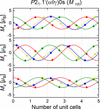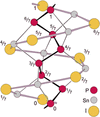issue contents
December 2023 issue

Cover illustration: In the tetrahedral helix of a four-dimensional counterpart of an icosahedron, the blue and green, white and black, yellow and orange balls form congruent helices with a non-crystallographic 20/9 screw axis – a rotation by 9 × 360°/20 = 162° and a shift along the axis. Similar to the union of two congruent 21 helices into helices 41 and 43, the pairs of the first and second, the first and third 20/9 helices define 40/9 and 40/11 helices, respectively; the parameters of the 40/11 helix correspond to the parameters of the α-helix. See Talis & Kucherinenko [Acta Cryst. (2023), B79, 537–546] .
scientific commentaries
 access
accessresearch papers


 access
access



 access
access

 access
access

 access
access



 access
access




 journal menu
journal menu





































